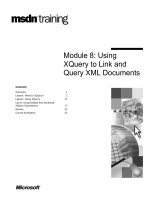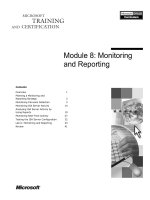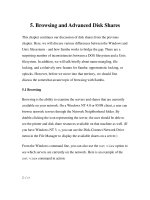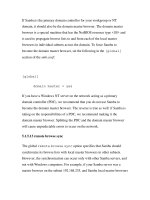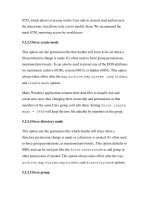Using 3g dongle recognition and reportin
Bạn đang xem bản rút gọn của tài liệu. Xem và tải ngay bản đầy đủ của tài liệu tại đây (923.26 KB, 7 trang )
International Journal of Computer Science and Information Security (IJCSIS),
Vol. 14, No. 10, October 2016
Using 3G Dongle, Recognition and Reporting based on
Pervasive Computing
Sonali Goyal
Department of Computer Science and Engineering
Haryana Engineering College, Jagadhri, Haryana, India
Email-
Neera Batra
Department of Computer Science and Engineering
Maharishi Markandeshwar University, Mullana, Haryana, India
Email-
Abstract-Biometric systems are the safety systems which are based on physical, biological and the humans behavioural.
To find any face in a given image is the main purpose of face detection and for detecting faces, face detection technique is
used. Automatic face recognition has become a highly active research area and health monitoring in automatic way is an
approach which is used to provide important information of human beings to their family members. An integrated
approach of PCA with ICA is used for feature extraction and with this combination; Neural Network is used as a
classifier. We have defined four categories in this so after recognizing an unknown face; we are sending messages to cell
phones of those members of category from which it belongs and also to their family members by using 3G dongle.
Implementation part is done by using MATLAB and recognition rate is to be calculated.
Keywords – Pervasive Computing, Biometric Syystem, Face Recognition, Principle Component Analysis,
Independent Component Analysis, Feed Forward Neural Network, Recognition Rate, 3G Dongle.
I. INTRODUCTION
To access the information and software applications anytime and anywhere, Pervasive Computing is used. In contrast
to Desktop Computing, this computing can occur using any type of device, in any location and in any format.
Pervasive Computing is a technology used for making computers so common that users are not even aware of their
physical presence. Supported self-care and services for home are the upcoming models of care. Advances in sensors
and network technologies have made this possible. A smart home is equipped with smart technologies provides
services that increase human way of living by providing its services i.e. safety, security etc. That allows elder person
to maintain living independently and securely in their homes. The care of elderly could be enhanced through remote
monitoring system, sensor technologies and communication systems. A form of home automation focuses on making
it possible for elderly and individual people to remain at home safe and comfortable. There are different types of face
recognition algorithms which are used to recognize the face. A hybrid or integrated combination of Principal
Component Analysis with Independent Component Analysis with Feed Forward Neural Network is used for obtaining
the desired results. Hybrid combination of PCA and ICA is used for feature extraction and Feed Forward Neural
Network is used for face recognition. The development of PCA is found by Eigen Vectors and with the help of Eigen
Vectors, features of given input are considered that are called as principle components. Its advantage is
dimensionality reduction process which includes the compression of data but there is no information is lost. ICA is a
technique which is very useful and used in systems involving multivariable data [8]. A Feed-Forward Network is a
simple neural network in which three layers are used first is input layer second is hidden layer and last one is output
layer [14].. We have taken four categories friend, family, neighbour and unknown. If person is recognized at door it
will check from which category it belongs, shows the type of category and then send message on mobile phone to all
the person of that category. Suppose a person is recognized as family member then the message will be send to all the
family members who are registered.
907
/>ISSN 1947-5500
International Journal of Computer Science and Information Security (IJCSIS),
Vol. 14, No. 10, October 2016
Fig. 1 Face Detection System
I.1 Pre-processing- Database containing front view and side view face images taken in 512 *512 pixels.
I.2 Feature Extraction- It is defined as the process of extracting useful with similar information through a face image
[2]. Meaningful and useful representation is derived for all the images by using a concept of converting the data
from high dimensional input space to a lower dimensional space [13].PCA and ICA algorithms are used for this
purpose.
I.3 Classifier- As a classifier, we use Feed Forward Neural Network for proposed method as it gives more accurate
results in comparison with individual methods.
All the steps are implemented using MATLAB.MATLAB is a language having high performance used for technical
computing and also used to generate computations in a way to use easily where mathematical notation is used to
express all the problems and solutions. While using MATLAB in face recognition, it stores the images in matrix
form and then use PCA + ICA algorithm for feature extraction.
Description for rest of the paper is: In section II, Proposed hybrid algorithm is defined. Results of Experiments are
shown in section III and last part is Conclusion and Future Scope in section IV.
II. PROPOSED HYBRID ALGORITHM
Work already done in Face recognition system uses a combination of single feature extraction technique with
classifier but work which is proposed now consists of four steps:
Training set
Pre-Processing
Feature
Extractor PCA
Feature
Extractor ICA
Classifier 1
Classifier 2
Fusion
Classified as ‘known’ or
‘unknown’ and its
category
Fig. 2 Hybrid Face recognition system
908
/>ISSN 1947-5500
International Journal of Computer Science and Information Security (IJCSIS),
Vol. 14, No. 10, October 2016
Using 3G Dongle, Recognition and Reporting based on Pervasive Computing
In first step, we take training set and pre-processing in which images are normalized by different methods.
In second step, Independent features have been extracted by using two face recognition algorithms PCA and ICA.
In third step, Feed Forward Neural Network is used for classification which classifies a given input image.
In fourth step, Combine all the outputs of each neural network and classifies input image which defines the category
of each input image. Steps for this hybrid algorithm are•
•
•
•
•
1.
2.
To establish Training set.
Apply mark features on training set to collect eye and mouth position.
Apply align faces to scale the face images in pgm format.
All the images are stored in matrix form named as C.
Apply PCA functionTo centre the data-Every training image is centred by subtracting the mean image from each of the training
images.
To calculate Co-variance matrix- Centred images in the matrix ‘A’ is multiplied with its transpose to form a
Co-variance matrix L.
L= A * A’
3.
To calculate Eigen vectors
[V, D]= Eig[1/(P-1) * (B’ * B))
•
1.
Apply ICA algorithm- from eigenvectors , ICA is calculated with help of filtering and learning.
Centering –
M= E{x} where x represents a zero mean variable.
2.
Whitening-Converts observed vector x in linear way so that a new vector x’ is obtained which is white.
E{x * x’}= I
3.
LearningXx=inv(wz) * x
4.
To check output co-variance
Cov(xx’)
Where uu= w * wz * xx
5.
Setting up of threshold value and show result.
III. EXPERIMENTS AND RESULT
Integration of Principal Component Analysis with Independent Component Analysis face recognition algorithms is
used for extraction of features and as a classifier or to recognize a face, Feed Forward Neural Network [10] is used.
Complete steps that how a face can be recognised and the procedure of sending messages on cell phone to the person
in a category are•
Mark features- purpose of this file is to mark features manually (left eye, right eye and teeth). It extracts six
independent features from ICA algorithm.
•
Align faces- This file is used to convert all the images present in jpg format into pgm format. After run this
step, it aligns the positions of mouth and eye of every image saves in Labels.mat.
909
/>ISSN 1947-5500
International Journal of Computer Science and Information Security (IJCSIS),
Vol. 14, No. 10, October 2016
Fig. 3 Align faces module
•
•
Laodface.mat- Purpose of this module is reshaping and the images present in pgm format are represented in
form of a matrix which is named as C.
Main.mat- When we run this main function, it gives result in the form of correctly matched images with the
images stored in training data. We are using two variables for calculating this result named as pc and rank
mat.
Fig. 4 Pc and Rankmat output
•
Train- In command window of MATLAB, we write nntool, then import the data named as inputs.mat and
targets.mat. After loading the data, we create a new network names as network1 and select input as train_ex ,
output as d, network is Feed Forward Distributed Network, Training function is trainlm, and learning
function is learngdm. When we open this network1, we can check the performance of this network which is
trained.
•
Test- In this, after recognizing the face image and find out the category of image, messages will be send to
all the persons of that category.
910
/>ISSN 1947-5500
International Journal of Computer Science and Information Security (IJCSIS),
Vol. 14, No. 10, October 2016
Using 3G Dongle, Recognition and Reporting based on Pervasive Computing
Fig. 5 Testing of image
This gives result of category from which image is matched. Above image belongs to neighbour category. If an image
is recognized, we can plot its performance graph to find out the accuracy and the graph is shown below.
Fig. 6 Plots for Performance
When the image is recognized, messages are sending to all the members of that category which is recognized.
The training database consists of 41 images and a sample database is shown in Fig. 7.
Fig. 7 Screenshot of Training Database
911
/>ISSN 1947-5500
International Journal of Computer Science and Information Security (IJCSIS),
Vol. 14, No. 10, October 2016
Table-1 Experimental Results
S. No
Name of technology
Recognition rate
1
PCA + Neural
Network
98%
2
PCA+ICA +Neural
Network
100%
Desired results will be obtained by using 3G dongle with MATLAB in such a way that messages will receive on cell
phone from the number which is registered with the dongle. We can send the messages to number of people at the
same time. Number of commands is used to produce operations for receiving the message and this message can be
received by number of people at the same time by inserting their numbers in code of MATLAB.
Fig. 8 Text Message on Phone
IV.CONCLUSION AND FUTURE SCOPE
A hybrid combination of PCA and ICA for feature extraction is proposed in this paper, Feed Forward Neural
Network is used for face recognition and 3G Dongle with MATLAB is used for sending the messages on cell phone.
Implementation part is done by using Matlab. For future work, use of sensors for an individual’s security at home
will be implemented.
REFERENCES
[1]
[2]
[3]
[4]
Vikram Solunke, Pratik Kudle and Abhijit Bhise, “A Comparision Between Feature Extraction Techniques For Face
Recognition”,International Journal of Emerging Research in Management and Technology, vol. 3, issue 2, pp. 38-41, Feb 2014.
Saurabh P.Bahurupi, D.S. Chaudhari, “Principal Component Analysis for Face Recognition”, International Journal of Engineering and
Advanced Technology, vol. 1, issue 5, pp. 91-94, June 2012.
S.Thakur, J.K. Sing, D.K. Basu, “Face Recognition using Principal Component Analysis and RBF Neural Networks”, IJSSST, vol. 10, no. 5.
Rabia Jafri and Hamri R. Arabnia, “A Survey of Face Recognition Techniques”, Journal of Information Processing Systems, vol. 5, no. 2,
June 2009.
912
/>ISSN 1947-5500
International Journal of Computer Science and Information Security (IJCSIS),
Vol. 14, No. 10, October 2016
Using 3G Dongle, Recognition and Reporting based on Pervasive Computing
[5]
Manal Abdullah, Majda Wazzan, Sahar Bo-saeed, “Optimizing Face Recognition using PCA”, International Journal of Artificial
Intelligence and Applications, vol. 3, no. 2, March 2012.
[6] Thea Franke, Catherine Tong, Maureen C. Ashe, “TheSecrets of Highly Active Older Adults”, Journal of Aging Studies, pp. 398-409, 2013.
[7] C.Bugli, P. Lambert, “Comparision between PCA and ICA in Electroencephalograms Modelling”, Biometric Journal, pp. 1-16, Aug 2016.
[8] D.A Tibaduiza, L.E. Mujica, “PCA vs ICA for Damage Detection”, 6th European Workshop on Structural Health Monitoring.
[9] Marian Stewart Bartlett, Javier R. Movellan, “Face Recognition by Independent Component Analysis”, IEEE Transactions on Neural
Networks, vol. 13, no. 6, Nov 2002.
[10] Lalita Gurjar, Nidhish Tiwari, “Face Detection using Feed Forward Neural Network in Matlab”, International Journal of Application or
Innovation in Engineering, vol. 3, issue 4, April 2014.
[11] Omaima N.A. AL-Allaf, “Review of Face Detection Systems Based Artificial Neural Networks Algorithms.”, International Journal of
Multimedia and its Applications, vol. 6, no. 1, Feb. 2014.
[12] Manisha Nirania, Mr. Krishan Kumar “Efficient Face Recognition Technique using PCA in Neural Network”, International Journal of
Advanced Research in Computer and Communication Engineering, vol. 4, issue 8, Aug. 2015.
[13] Ganesh V. Linge, Minakshee M. Panwar “Face Recognition using Neural Network & Principal Component Analysis”, International Journal
of Current Engineering and Technology, vol. 4, no. 3, June 2014.
[14] Kulwinder Singh, Ashok Sardana, Kiranbir Kaur “Face Recognition by Plotting Different Facial Marks using Neural Networks”,
International Journal of Computer Science & Technology, vol. 2, issue 2, June 2011.
[15] Sujata G.Bhele, V.H. Mankar “A Review Paper on Face Recognition Techniques”, International Journal of Advanced Research in
Computer Engineering & Technology, vol. 1, issue 6, Oct. 2012.
[16] Dae-Man Han, Jae-Hyun lim “Smart Home Energy Management System using IEEE 802.15.4 & Zigbee”, IEEE, vol. 56, issue 5, pp. 21-24.
[17] Nojun Kwak, Chong-Ho Choi, Jin Young Choi “Feature Extraction Using ICA”, Springer, pp. 568-573.
913
/>ISSN 1947-5500




